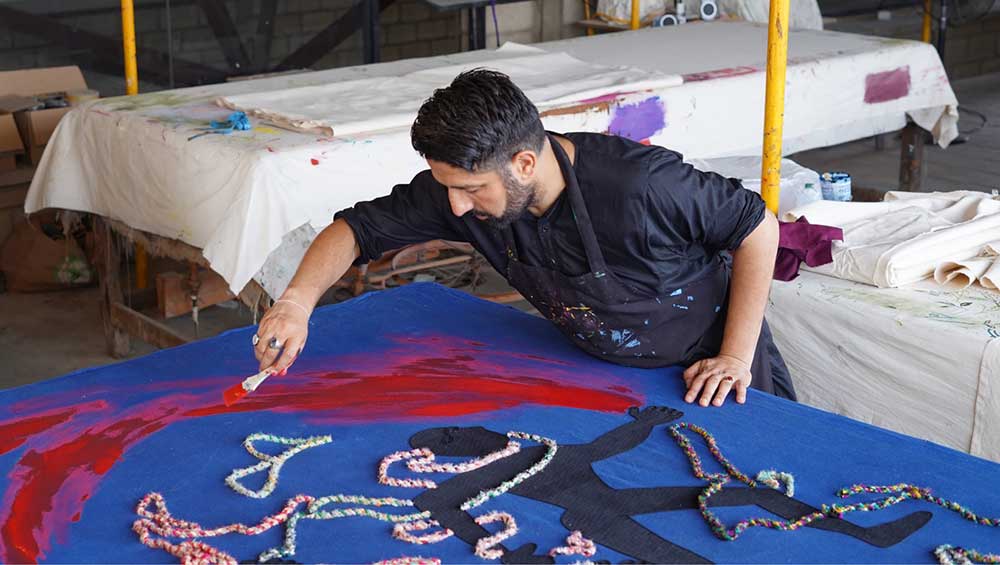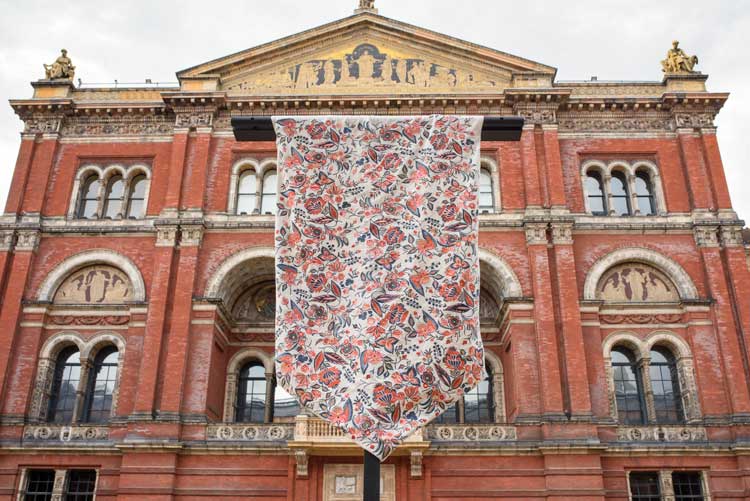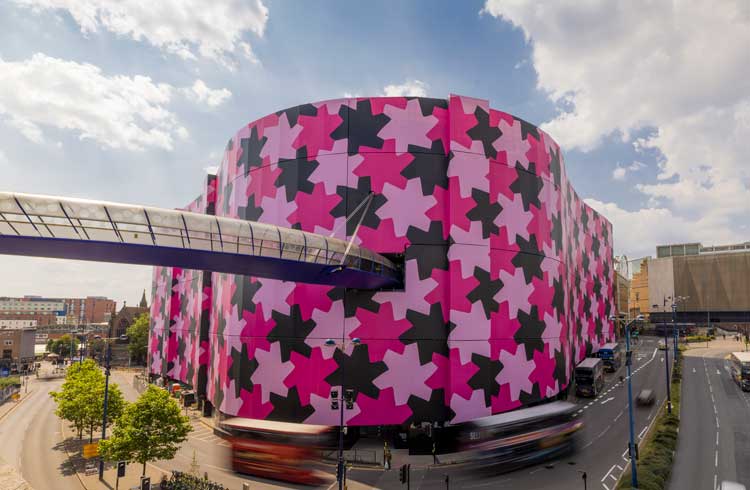
Osman Yousefzada. Photo courtesy the artist.
by CLEO ROBERTS-KOMIREDDI
Osman Yousefzada (b1977, Birmingham) is an artist able to see, think and work with disciplinary abandon. His career began in fashion with his own label, Osman, which was known for marrying minimalist shapes with decadent embroidery and adornments drawn from his South Asian background (he is the son of Pakistani-Afghan immigrants). Stars such as Beyoncé, Lady Gaga and Emma Watson have worn his designs, but Yousefzada was always engaged with art, exhibiting in group shows and producing a cultural magazine with cover commissions including Anthea Hamilton. An invitation to exhibit at the Ikon Gallery in 2018 allowed Yousefzada to expand this practice and critically assess the networks of production, migration and female agency (or lack of) at the heart of the fashion establishment whilst also exploring domestic violence and class inequality.
Titled Being Somewhere Else, his first solo exhibition at an art institution did not allow itself to be confined to just the gallery. Over four days, Yousefzada filled Birmingham’s city centre with fashion, film, performance, talks and music events for The Migrant Festival. His practice continues to embrace collaboration and has expanded. His critically acclaimed memoir, The Go-Between: A Portrait of Growing up Between Different Worlds was published last year, and he is doing a PhD at the Royal College of Art alongside a fellowship at Jesus College, University of Cambridge. As his memoir comes out in paperback this month, he discusses his multidisciplinary approach and the conversations he is intent on provoking.
Cleo Roberts-Komireddi: From your education, which traverses anthropology and art, to how your projects manifest, you have cultivated an interdisciplinary practice, and you often collaborate with those from the fields of dance, writing and academia. How do you see your various practices interrelating?
Osman Yousefzada: I am very much about no borders, on many levels. I just use one title for myself, which is artist and writer. Most of my conversations are breaking pedagogical, institutional and cultural boundaries where we’re all hyper-specialised and create hierarchies and permission-oriented structures. I started off in anthropology and then went to art school. Then I was making zines for a while and also making clothes. But it’s an expansive conversation for me: rather than a conversation that is segmented, it is continuous. It’s the same conversations for me on migration and belonging across different mediums.
CRK: How do you navigate the external pressure to define yourself?
OY: The way we transact with the outside world is very much about having a brand and a particular thing that we aspire to be the best at. If you look at guild systems or caste systems, we’ve always been specialised. I come from a generation of carpenters and builders and that’s what’s in my blood, and then you put the efficiency of the factory system into it and the capitalist system on top of it. It becomes a big global, colonial, extractive system where we somehow transact with each other in a way that I find ignores so many different things. It ignores the injustices and ignores what happens at those intersections. And it’s there where there’s really a conversation that I want to have.
-Victoria-and-Albert-Museum,-London.jpg)
Osman Yousefzada, Intervention 2, installation view, What Is Seen And What Is Not, V&A Museum, London, 2022. Photo: Victoria and Albert Museum, London.
CRK: You have been very frank about the racial prejudice that courses through the creative industries and British life, writing articles in the Guardian and Business of Fashion, for example, that advocate for change. Last year, as part of your major British Council commission What Is Seen and What Is Not, at the V&A, you organised a symposium. What issues were you tackling?
OY: The symposium was concerned with art and class and looking at who could call themselves an artist and the barriers to entry. I invited many different people, including the artist Prem Sahib and the architect Asif Khan, along with other thinkers and the V&A curators.
I gave a lecture called My Mother as the Artist. It was a confessional lecture stating everything that I’ve copied from my mother, who was a seamstress, and I put her work next to mine. There were two things I was interested in. One is domestic production and how, as a second-generation child of immigrants, I want to feel the work I’m making or the work I was surrounded by in a house, which was very underclass, where the inhabitants were illiterate, that there’s value in that work, not only sentimental or crafty. And that it can be reimagined to a point where it is seen as cultural production.
Second, there are the barriers to entry of who can call themselves an artist. There’s the obvious conversation about time: time being the ultimate luxury and it’s only middle-class artists who can take the time out, but my questions were also around craft and art. Where does it marry? Where does it finish? The idea of a maker, whether it’s decorative or not decorative, or whether it has meaning and the meaning allows it to enter into a contemporary art space, I find a very layered kind of world.

Osman Yousefzada, Intervention 3, installation view, What Is Seen And What Is Not, V&A Museum, London, 2022. Photo: Victoria and Albert Museum, London.
CRK: What was your introduction to the arts?
OY: When I was growing up, I didn’t know what an art school was, or if you could do that for living. I’d been to a museum only once or twice until I left Birmingham and came to London when I was 18. And you know these institutions, they put you in your place. In the grandest of these institutions with their soaring arches, you walk into this space, and it’s like you’re among them, and if you’re not used to such spaces, it clearly creates these invisible barriers: you’re allowed to be there, but you’re not allowed to be part of them.
The only way that I could find an outlet that was identity-forming or trying to understand who I was, was through dressing up. It was a kind of performative element. Then I met people in London who were studying more interesting subjects and had more interesting careers than I was signposted to have when I was a kid. That opened up different ways of thinking and I think that’s what I’ve been trying to search for in the types of work I want to make. It’s about what it means to be able to plant trees that other people may sit underneath and where you open doors for other people. That’s something which is key to what I do.
-Victoria-and-Albert-Museum,-London.jpg)
Osman Yousefzada, Intervention 1, installation view, What Is Seen And What Is Not, V&A Museum, London, 2022. Photo: Victoria and Albert Museum, London.
CRK: You mention the architecture of the museum asserting itself and I would say that the V&A, within the context of other London institutions, is one of the most imposing. The grandiose walkway up from the street into that expansive atrium is dwarfing. Were there challenges in coming there as an invited artist and being asked to work with a very loaded space that has its roots in colonialism and things purged from various parts of the world?
OY: It was really important to have my three tapestry works, Intervention 1, open up the show and really put the museum’s heritage in perspective. They are inspired by The Book of Omens and the Falnama, a set of oracle cards that were used by Indian and Ottoman fortune-tellers. A lot of the V&A’s objects are anthropological and of a particular time. To put in interventions, as I did, which were equally powerful and had their own narrative – which was really about the other but also about sharing and coming together and looking at our entangled past as well as looking at it for a hopeful future, in a non-judgmental way – was really important. It was enough that the work was there, that those conversations were not hiding in the museum’s many crevices or niches. It was there and open in front of you that I didn’t want to be a good immigrant in that space.
CRK: You talk about sharing and bringing people together, and the part of the commission in the V&A’s John Madejski Garden, Intervention 3, a series of charpai (South Asian daybeds) and stackable peerhi stools seemed particularly successful at doing that. The works transformed the area, where it is usually the building that speaks but not the items surrounding it. These works were bright with the seating parts woven from the offcuts of fabrics found on the floors of Pakistan’s clothing factories. Did people interact with them?
OY: My approach was not to make a non-noticeable conversation in the corner. It’s about saying: “I’m here and I’m here to stay.” I think what was interesting is those seating sculptures were made from original colonial doors, which were restrictive at one time. They would have been gates that blocked access. Once they shifted on their axis, they became these platforms for everyone to sit on.
People were lying on them instead of sitting daintily with an earl grey tea and scone at those very stylised marble tables and metal chairs. I saw couples and families reclining on them. There were about six or seven people once and I remember worrying about whether the piece could take it. It was about how we take space and where are we recognised? Is it the curry shop or the high street, or how do we take space in institutions that are such hallowed spaces? It’s fine if you are a brown, black person who has a middle-class experience, but how do you have those conversations if you don’t see yourself as part of that world?
-Victoria-and-Albert-Museum,-London.jpg)
Osman Yousefzada, Intervention 3, installation view, What Is Seen And What Is Not, V&A Museum, London, 2022. Photo: Victoria and Albert Museum, London.
CRK: You are especially concerned with how women relate to these spaces. You installed a wooden set of open shelves reminiscent of street shrines across South Asia that held a collection of meticulously wrapped domestic objects, each indiscernible but obviously prized. Whose objects are they?
OY: The women I’m concerned with are the female migrants from less privileged backgrounds, from rural areas who came into large metropolises who weren’t the women who swapped their wedding trousseau cupboards for fitted MFI wardrobes and hung all their items out. What that work was exploring were the women like my mother, who was illiterate and couldn’t read or write in her mother tongue or English. I’m interested in how they started understanding this disposable consumerism, this world of plenty from their world of restraint and make-do. How do you protect these objects? These objects became those territories. I mean, of course, many people saw that they were classic ways of being ready to leave a space and migrate. But, for me, they were much more about this idea of female agency, female space and patriarchy.

Osman Yousefzada, Infinity Pattern 1, 2021. Selfridges Department Store, Birmingham, UK. Photo: Jason Alden.
CRK: The method of wrapping you have developed has been described by Jaspar Joseph-Lester, head of sculpture at the Royal College of Art, as “anti-Christo” in that it is not about spectacle and iconising the object, but rather concealing and obscuring. But you did have a Christo moment in 2021 when you wrapped the facade of Selfridges in Birmingham with 9,000 sq metres of printed canvas.
OY: I kind of turned that on its head because I wanted to talk about community and migration, and I could hardly compress Selfridges into a small domestic kind of object. The idea of being able to wrap and work across different scales and media is important to ignite the same conversation. You could see it from Birmingham’s Balsall Heath area which is one of the city’s most deprived areas. The work was linked to the themes of my V&A exhibition: how do you occupy space when, as an immigrant, you are only seen as useful when you add something to your wider community or host culture? These areas in Birmingham have long been seen as ghetto areas and the city has been described as the jihadi capital of England. They are seen as places that don’t necessarily have any use for the greater good of British society. What I did with the work at Selfridges was really to allow it to be seen. The pattern was an infinity pattern and a geometric idea of borderless spaces where the pattern extends out into the horizon. It has no perspective; you’re allowed to look beyond the natural border of building.
CRK: This concept of being the “good immigrant” is something you continuously revisit. How do you perceive yourself in relation to that, especially when working in hallowed institutions such as the V&A and the University of Cambridge where you currently have a fellowship?
OY: I try to have conversations within institutions and public realms that allow me to open up some of these conversations and provide much-needed platforms. I’m not a theorist. I’m a practitioner, a maker. I’m interested in how, through my work, a sense of activism allows change to happen. As I said earlier, it’s not that I sit under the shade of the trees I planted but the trees that I plant are for others to sit under and are for breaking pedagogical, institutional and cultural permissions. Our futures need to be more harmonious to understand each other’s cultures and ideas and ways of being. That’s why I’m much more interested in interdisciplinary modes and how you create those apertures for people to look through.
• The Go-Between: A Portrait of Growing up Between Different Worlds, published by Canongate, is out in paperback on 26 January.